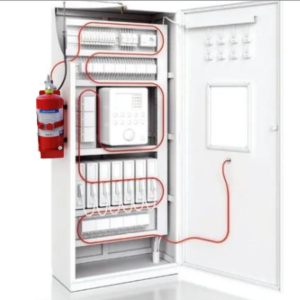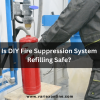![]()
Fire Immuniser
+91-7829629111
Email: info@variex.in
Varistor Technologies Pvt. Ltd.
Block-1, First Floor, Ardente Office One, Hoodi Circle, ITPL Main Road, Bengaluru, Karnataka 560048, IN
Tube Based Fire Suppression System Electrical Cabinets
In environments where electrical cabinets house crucial equipment, ensuring fire safety is paramount. Traditional fire suppression systems, such as sprinklers or gas-based systems, may not be suitable due to the potential for water damage or the presence of sensitive electronic components. Tube-based fire suppression systems offer a specialized solution tailored to the unique needs of electrical cabinets, providing rapid and effective fire suppression while minimizing damage to equipment.
Working Principle
Tube-based fire suppression systems utilize a flexible polymer tube, typically made of materials like thermoplastic or fluoropolymer, installed within the electrical cabinet. This tube is pressurized and filled with a fire-suppressing agent, often a clean agent like FM-200 or Novec 1230, chosen for its effectiveness and minimal impact on the environment. The tube is strategically routed to cover critical areas within the cabinet, such as circuitry, wiring, and other potential fire sources.
When a fire occurs, the heat from the flames causes the tube to rupture at the point nearest the source. This rupture releases the suppressant agent directly onto the fire, quickly extinguishing it. The system's rapid response is crucial for preventing the fire from spreading and causing extensive damage to the electrical equipment.
Advantages
- Space Efficiency: Tube-based systems are compact and can be installed within the confined space of electrical cabinets without impeding access to equipment or obstructing airflow.
- Fast Response Time: These systems detect and suppress fires rapidly, minimizing damage to electrical components and reducing downtime.
- Clean Agent Suppression: The use of clean agents ensures that no residue is left behind after discharge, eliminating the risk of damage to sensitive electronic equipment.
- Non-Toxic: The suppressant agents used in tube-based systems are non-toxic, making them safe for use in occupied spaces and reducing health risks to personnel.
- Low Maintenance: These systems require minimal maintenance, typically limited to periodic inspections to ensure proper functionality, making them cost-effective and convenient for long-term use.
Applications
Tube-based fire suppression systems for electrical cabinets are suitable for a wide range of applications, including:
- Data Centers: Protecting critical IT infrastructure, including servers, switches, and storage systems.
- Industrial Facilities: Safeguarding control panels, electrical cabinets, and machinery in manufacturing plants and processing facilities.
- Telecommunications: Ensuring the uninterrupted operation of telecommunications equipment, including switches, routers, and transmission equipment.
- Commercial Buildings: Securing electrical distribution panels, power supplies, and other critical equipment in office buildings, retail spaces, and hospitality venues.
- Transportation: Protecting electrical systems in vehicles, including trains, airplanes, ships, and buses, to ensure passenger safety and operational continuity.
Advanced Features and Considerations in Tube-Based Fire Suppression Systems for Electrical Cabinets
As technology advances, so do fire suppression systems designed to protect electrical cabinets and sensitive equipment. Tube-based fire suppression systems have evolved to incorporate advanced features and considerations to enhance their effectiveness and reliability in safeguarding critical environments. Below are additional details on the advanced features and considerations of these systems:
1. Pressure Management Systems:
- Some tube-based fire suppression systems employ pressure management systems to maintain optimal pressure levels within the tubing. These systems ensure consistent agent discharge and help prevent leakage or inadvertent discharge, enhancing system reliability.
- Pressure management systems may include pressure sensors, valves, and regulators to monitor and control the pressure of the suppressant agent within the tubing.
2. Remote Monitoring and Control:
- Remote monitoring and control capabilities allow operators to monitor the status of the fire suppression system and remotely activate or deactivate it as needed.
- Integration with building management systems or centralized monitoring platforms enables real-time monitoring of system health, status alerts, and remote diagnostics, enhancing overall fire safety management.
3. Pre-Engineered Design:
- Pre-engineered tube-based fire suppression systems are designed for specific applications and cabinet configurations, simplifying installation and ensuring optimal coverage.
- These pre-engineered systems come with pre-configured tubing lengths, agent quantities, and mounting accessories tailored to the requirements of electrical cabinets, reducing installation time and costs.
4. Enhanced Agent Distribution:
- Advanced nozzle designs and distribution methods ensure uniform coverage of suppressant agent within the electrical cabinet, effectively targeting fire sources and maximizing extinguishing efficiency.
- Multi-directional nozzles or nozzle arrays may be used to disperse the suppressant agent evenly across the protected area, minimizing the risk of re-ignition or insufficient coverage.
5. Environmental Considerations:
- Increasing emphasis is placed on selecting environmentally friendly suppressant agents that have minimal impact on the environment and comply with regulatory standards.
- Clean agents with low global warming potential (GWP) and ozone depletion potential (ODP) are preferred to mitigate environmental concerns and ensure sustainable fire suppression solutions.
6. Compatibility with Enclosure Materials:
- Tube-based fire suppression systems are designed to be compatible with a wide range of enclosure materials commonly used in electrical cabinets, including metals, plastics, and composites.
- Compatibility considerations ensure that the suppressant agent and tubing materials do not react adversely with the enclosure materials, preserving the integrity of the cabinet and its contents.
7. Integration with Fire Detection Systems:
- Integration with fire detection systems, such as smoke detectors or heat sensors, enables early detection of fire events and automatic activation of the fire suppression system.
- Seamless integration ensures prompt response to fire incidents, reducing the risk of fire spreading and minimizing potential damage to equipment and infrastructure.
Conclusion
Advanced features and considerations in tube-based fire suppression systems for electrical cabinets enhance their effectiveness, reliability, and compatibility with modern technological environments. Pressure management systems, remote monitoring capabilities, pre-engineered designs, and environmental considerations contribute to the overall efficiency and sustainability of these systems. By incorporating advanced features and considerations, tube-based fire suppression systems provide robust fire protection for critical electrical equipment, ensuring the safety and continuity of operations in various industrial and commercial applications.
Frequently Asked Questions
A tube-based fire suppression system is a specialized fire protection solution designed for electrical cabinets and enclosures containing sensitive electronic equipment. It consists of a flexible polymer tube filled with a fire-suppressing agent, strategically installed within the cabinet to detect and extinguish fires rapidly.
The system operates on a simple principle: when a fire occurs, the heat causes the tube to rupture at the point nearest the fire source, releasing the suppressant agent directly onto the flames. This rapid response extinguishes the fire, preventing it from spreading and minimizing damage to the electrical equipment.
Tube-based fire suppression systems typically use clean agents such as FM-200 or Novec 1230, chosen for their effectiveness in extinguishing fires without leaving residue or causing damage to sensitive electronic equipment. These agents are environmentally friendly and safe for use in occupied spaces.
Tube-based systems are designed to be versatile and can be adapted to various types of electrical cabinets and enclosures. However, it's essential to ensure compatibility with the cabinet's materials and layout to achieve optimal coverage and effectiveness.
Some key advantages include:
- Rapid response time: Swift detection and suppression of fires, minimizing damage and downtime.
- Clean agent suppression: No residue left behind, reducing the risk of equipment damage.
- Space efficiency: Compact design suitable for confined cabinet spaces.
- Non-toxic agents: Safe for use in occupied areas, posing no health risks to personnel.
Final Say
We at VariEx.in or Variexonline.com have mastered the art of designing, installing, inspecting, and fixing automatic sprinkler systems with the help of our in-house team, which is capable of delivering the fire sprinkler services you need, whether large or small and at affordable cost.
To schedule a fire sprinkler installation, or you think our services could benefit your commercial property, contact us online or give us a call at, 7829629111









